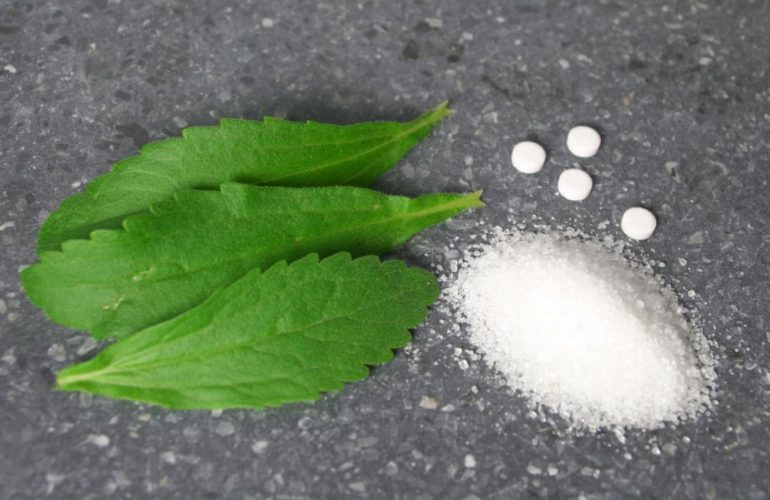Stevia is known to a sugar substitute whose usage has been increasing at an alarming rate since few years.
Recently stevia became very popular by becoming an integral part of fad diets like low carb Diet, low sugar or no sugar diet or keto diet etc.
Not all Stevia are made Same: Types of Stevia
Depending on the level of processing, stevia can be found in various forms.
- Green Leaf Stevia: This is the least processed form of stevia. It is 30-40 times sweeter than sugar and is also slightly bitter to taste.
- Stevia Extracts: Its extracts are 200 times sweeter than sugar and comparatively less bitter to green leaf stevia.
- Altered Stevia: This is the highly processed form of stevia which contains GMO ingredients. It is 200-400 times sweeter than sugar.
- Stevia Blend: Stevia is often paired with other sweeteners such as: maltodextrin, sodium saccharin, sodium cyclamate, aspartame.
Multiple forms of Stevia
- Liquid
- Powder
- Granulated
- Dried leave
Taste of Stevia
Not everyone likes the way it tastes. Some people find it bitter, but others think stevia tastes like menthol.
What happens to Stevia Sweeteners after Consumption?
- Steviol glycosides are not absorbed in the upper gastrointestinal tract and therefore do not contribute to any calories or impact blood glucose levels.
- When they reach the colon, gut microbes cleave off the glucose molecules and use them as an energy source.
- The remaining Steviol backbone is then absorbed via the portal vein, metabolized by the liver and excreted in urine.
Stevia’s Difficult & Rocky History
- In 1991 stevia was banned in the U.S. due to early studies suggesting it’s side effects.
- In 1995, the Food and Drug Administration (FDA) allowed stevia only to be imported and sold as a food supplement, but not as a sweetener.
- Several companies argued to the FDA that stevia should be categorized as “Generally Recognized as Safe” (GRAS).
- In December 2008, the FDA declared stevia GRAS, and allowed its use in mainstream U.S. food production. After the involvement of big commercial giants like Coca Cola and Pepsi.
- The FDA hasn’t approved whole-leaf stevia or crude stevia extracts for use as food additives because of concerns about possible health effects.
- Stevia products found on grocery store shelves, such as Truvia and Stevia in the Raw, don’t contain whole stevia leaf.
- They’re made from a highly refined stevia leaf extract called rebaudioside A (Reb-A).
- Stevia Extract Got Approved in India in 2015-16 by FSSAI.
- In India Food Standards Authorities calls it a natural sweetener and not a food item.
- Legal Action would be taken if anyone’s caught selling raw Stevia says FSSAI Food Safety & Standard Authority of India.
Truth behind Processed or Refined Stevia
What Is in Stevia?
The stevia plant contains the following Steviol glycoside compounds that give its leaves the enormous sweetness:
- Stevioside: 150-300
- Rebaudioside A to F: 50-400
- Rubusoside: 110
- Steviolmonoside: N/A
- Steviolbioside: 100-125
- Dulcoside A: 50-120
- Of these, you can find rebaudioside A and stevioside in the most significant amounts in stevia leaves.
- 99% of stevia products have very little stevia in them at all.
- In the 1930s, chemists in France isolated stevioside (otherwise known as rebaudioside A), the compound in the leaves that is responsible for their sweetness.
- Stevia is highly processed using a patentable chemical-laden process. In fact, Truvia (Coca-Cola’s branded product) goes through about 40 steps to process the extract from the leaf.
- Some of these processes involve chemicals such as acetone, methanol, ethanol, acetonitrile, and isopropanol.
To make matters worse, some of these chemicals are known carcinogens.
Health benefits of Using Stevia as per Market Experts
- May aid diabetes.
- May aid weight loss.
- May regulate blood pressure.
- May aid improve oral health.
- May lower down cholesterol.
- May prevents osteoporosis: By promoting the absorption of calcium.
- May strengthen immune system.
Possible Side-effects of Stevia
- Avoid if you are pregnant.
- Avoid giving it to kids.
- Allergic reactions: People who are allergic to ragweed, marigolds, daisies, and related plants may experience allergic symptoms.
- May alter gut bacteria.
- May lead to overeating.
- May Lead to Endocrine Disruption.
- As per FDA Raw stevia can harm your kidneys, reproductive system, and cardiovascular system.
- It may also drop blood pressure too low by reacting with medicines that lower your blood sugar.
- Some people can experience bloating or nausea while some may feel dizzy, muscle pain, and numbness.
Points To Remember
- Stevia is not any magical ingredient and must be consumed in moderation.
- If you eat too many sugar-free foods, you can still gain weight if these foods have other ingredients that contain calories.
- It’s also important to read labels on stevia products if you want to avoid artificial sweeteners.
- The FDA is generally cool with these ingredients, and foods that have this label should contain no artificial or synthetic colors or flavors. But “natural flavors” could still include ingredients that are highly processed.
This was all you need to know about the artificial, zero calorie, sugar free sweetener : “STEVIA”.
